Susan B. Anthony
This article's lead section may be too short to adequately summarize the key points. (September 2010) |
This article needs additional citations for verification. (September 2010) |
Susan Brownell Anthony | |
|---|---|
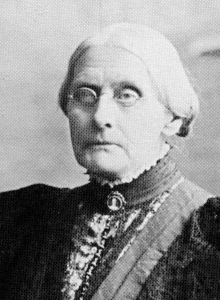 | |
| Born | February 15, 1820 |
| Died | March 13, 1906 (aged 86) |
| Occupation(s) | Suffragist, women's rights advocate |
Susan Brownell Anthony (February 15, 1820 – March 13, 1906) was a prominent American civil rights leader who played a pivotal role in the 19th century women's rights movement to introduce women's suffrage into the United States. She traveled the United States, and Europe, and averaged 75 to 100 speeches per year.[1]
Early life
Susan B. Anthony was born and raised in West Grove, near Adams, Massachusetts. She was the second oldest of seven children—Guelma Penn (1818–1873), Hannah Lapham (1821–1877), Daniel Read (1824–1904), Mary Stafford (1827–1907), Eliza Tefft (1832–1834), and Jacob Merritt (1834–1900)—born to Daniel Anthony (1794–1862) and Lucy Read (1793–1880). One brother, publisher Daniel Read Anthony, would become active in the anti-slavery movement in Kansas, while a sister, Mary Stafford Anthony, became a teacher and a woman's rights activist. Anthony remained close to her sisters throughout her life.
Her earliest American ancestors were the immigrants John Anthony (1607 - 1675), who was from Hempstead, Essex and his wife Susanna Potter (c. 1623 - 1674), who was from London, Middlesex.[2]
Anthony's father Daniel was a cotton manufacturer and abolitionist, a stern but open-minded man who was born into the Quaker religion.[3] He did not allow toys or amusements into the household, claiming that they would distract the soul from the "inner light." Her mother, Lucy, was a student in Daniel's school; the two fell in love and agreed to marry in 1817, but Lucy was less sure about marrying into the Society of Friends (Quakers). Lucy attended the Rochester women’s rights convention held in August 1848, two weeks after the historic Seneca Falls Convention, and signed the Rochester convention’s Declaration of Sentiments. Lucy and Daniel Anthony enforced self-discipline, principled convictions, and belief in one's own self-worth.
Susan was a precocious child, having learned to read and write at age three.[4] In 1826, when she was six years old, the Anthony family moved from Massachusetts to Battenville, New York. Susan was sent to attend a local district school, where a teacher refused to teach her long division because of her gender. Upon learning of the weak education she was receiving, her father promptly had her placed in a group home school, where he taught Susan himself. Mary Perkins, another teacher there, conveyed a progressive image of womanhood to Anthony, further fostering her growing belief in women's equality.
In 1837, Anthony was sent to Deborah Moulson's Female Seminary, a Quaker boarding school in Philadelphia. She was not happy at Moulson's, but she did not have to stay there long. She was forced to end her formal studies because her family, like many others, was financially ruined during the Panic of 1837. Their losses were so great that they attempted to sell everything in an auction, even their most personal belongings, which were saved at the last minute when Susan's uncle, Joshua Read, stepped up and bid for them in order to restore them to the family.
In 1839, the family moved to Hardscrabble, New York, in the wake of the panic and economic depression that followed. That same year, Anthony left home to teach and pay off her father's debts. She taught first at Eunice Kenyon's Friends' Seminary, and then at the Canajoharie Academy in 1846, where she rose to become headmistress of the Female Department. Anthony's first occupation inspired her to fight for wages equivalent to those of male teachers, since men earned roughly four times more than women for the same duties.
In 1849, at age 29, Anthony quit teaching and moved to the family farm in Rochester, New York. She began to take part in conventions and gatherings related to the temperance movement. In Rochester, she attended the local Unitarian Church and began to distance herself from the Quakers, in part because she had frequently witnessed instances of hypocritical behavior such as the use of alcohol amongst Quaker preachers. As she got older, Anthony continued to move further away from organized religion in general, and she was later chastised by various Christian religious groups for displaying irreligious tendencies.
In her youth, Anthony was very self-conscious of her looks and speaking abilities. She long resisted public speaking for fear she would not be sufficiently eloquent. Despite these insecurities, she became a renowned public presence, eventually helping to lead the women's movement.
Early social activism
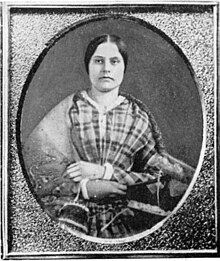
Universal manhood suffrage, by establishing an aristocracy of sex, imposes upon the women of this nation a more absolute and cruel despotism than monarchy; in that, woman finds a political master in her father, husband, brother, son. The aristocracies of the old world are based upon birth, wealth, refinement, education, nobility, brave deeds of chivalry; in this nation, on sex alone; exalting brute force above moral power, vice above virtue, ignorance above education, and the son above the mother who bore him.
National Woman Suffrage Association.[5]
In the era before the American Civil War, Anthony took a prominent role in the New York anti-slavery and temperance movements. In 1836, at age 16, Susan collected two boxes of petitions opposing slavery, in response to the gag rule prohibiting such petitions in the House of Representatives.[6] In 1849, at age 29, she became secretary for the Daughters of Temperance, which gave her a forum to speak out against alcohol abuse, and served as the beginning of Anthony's movement towards the public limelight.
In late 1850, Anthony read a detailed account in the New York Tribune of the first National Women's Rights Convention in Worcester, Massachusetts. In the article, Horace Greeley wrote an especially admiring description of the final speech, one given by Lucy Stone. Stone's words catalyzed Anthony to devote her life to women's rights.[7] In the summer of 1852, Anthony met both Greeley and Stone in Seneca Falls.[8]
In 1851, on a street in Seneca Falls, Anthony was introduced to Elizabeth Cady Stanton by a mutual acquaintance, as well as fellow feminist Amelia Bloomer. Anthony joined with Stanton in organizing the first women's state temperance society in America after being refused admission to a previous convention on account of her sex, in 1851. Stanton remained a close friend and colleague of Anthony's for the remainder of their lives, but Stanton longed for a broader, more radical women's rights platform. Together, the two women traversed the United States giving speeches and attempting to persuade the government that society should treat men and women equally.
Anthony was invited to speak at the third annual National Women's Rights Convention held in Syracuse, New York in September 1852. She and Matilda Joslyn Gage both made their first public speeches for women's rights at the convention.[9] Anthony began to gain notice as a powerful public advocate of women's rights and as a new and stirring voice for change. Anthony participated in every subsequent annual National Women's Rights Convention, and served as convention president in 1858.
In 1856, Anthony further attempted to unify the African-American and women's rights movements when, recruited by abolitionist Abby Kelley Foster,[10] she became an agent for William Lloyd Garrison's American Anti-Slavery Society of New York. Speaking at the Ninth National Women’s Rights Convention on May 12, 1859, Anthony asked "Where, under our Declaration of Independence, does the Saxon man get his power to deprive all women and Negroes of their inalienable rights?"
The Revolution
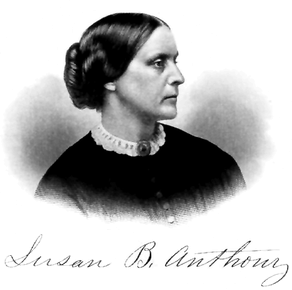
On January 1, 1868, Anthony first published a weekly journal entitled The Revolution. Printed in New York City, its motto was: "The true republic—men, their rights and nothing more; women, their rights and nothing less." Anthony worked as the publisher and business manager, while Elizabeth Cady Stanton acted as editor. The main thrust of The Revolution was to promote women’s and African-Americans’ right to suffrage, but it also discussed issues of equal pay for equal work, more liberal divorce laws and the church’s position on women’s issues. The journal was backed by independently wealthy George Francis Train, who provided $600 in starting funds. His financial support ceased by May 1869, and the paper began to operate in debt. Anthony insisted on expensive, high-quality printing equipment, and she paid women workers the high wages she thought they deserved. She banned any advertisements for alcohol- and morphine-laden patent medicines; all such medicines were abhorrent to her. However, revenue from non-patent-medicine advertisements was too low to cover costs.[11]
In June 1870, Laura Curtis Bullard, a Brooklyn-based writer whose parents became wealthy from selling a popular morphine-containing patent medicine called "Mrs. Winslow's Soothing Syrup", bought The Revolution for one dollar, with Anthony assuming its $10,000 debt, an amount equal to $241,000 in current value. Anthony used her lecture fees to repay the debt, completing the task in six years. Under Bullard, the journal adopted a literary orientation and accepted patent medicine ads, but it folded in February 1872.[12]
American Equal Rights Association
In 1869, long-time friends Frederick Douglass and Susan B. Anthony found themselves, for the first time, on opposing sides of a debate. The American Equal Rights Association (AERA), which had originally fought for both blacks’ and women’s right to suffrage, voted to support the 15th Amendment to the Constitution, granting suffrage to black men, but not women. Anthony questioned why women should support this amendment when black men were not continuing to show support for women’s voting rights. Partially as a result of the decision by the AERA, Anthony soon thereafter devoted herself almost exclusively to the agitation for women's rights.
On November 18, 1872, Anthony was arrested by a U.S. Deputy Marshal for voting illegally in the 1872 Presidential Election two weeks earlier. She had written to Stanton on the night of the election that she had "positively voted the Republican ticket—straight...". She was tried and convicted seven months later, despite the stirring and eloquent presentation of her arguments that the recently adopted Fourteenth Amendment, which guaranteed to "all persons born or naturalized in the United States" the privileges of citizenship, and which contained no gender qualification, gave women the constitutional right to vote in federal elections. Her trial took place at the Ontario County courthouse in Canandaigua, New York. The sentence was a fine, but not imprisonment; and true to her word in court, she never paid the penalty for the rest of her life. The trial gave Anthony the opportunity to spread her arguments to a wider audience than ever before.[13]
Anthony toured Europe in 1883 and visited many charitable organizations. She wrote of a poor mother she saw in Killarney that had "six ragged, dirty children" to say that "the evidences were that 'God' was about to add a No. 7 to her flock. What a dreadful creature their God must be to keep sending hungry mouths while he withholds the bread to fill them!"[14]
In 1893, she joined with Helen Barrett Montgomery in forming a chapter of the Woman’s Educational and Industrial Union (WEIU)[15] in Rochester. In 1898, she also worked with Montgomery to raise funds to open opportunities for women students to study at the University of Rochester.
National suffrage organizations
In 1869, Anthony and Elizabeth Cady Stanton founded the National Woman's Suffrage Association (NWSA), an organization dedicated to gaining women's suffrage. Anthony was vice-president-at-large of the NWSA from the date of its organization until 1892, when she became president.
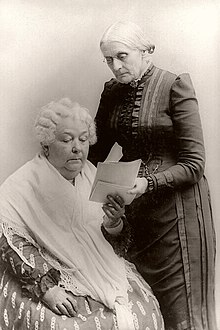
In the early years of the NWSA, Anthony made many attempts to unite women in the labor movement with the suffragist cause, but with little success. She and Stanton were delegates at the 1868 convention of the National Labor Union. However, Anthony inadvertently alienated the labor movement not only because suffrage was seen as a concern for middle-class rather than working-class women, but because she openly encouraged women to achieve economic independence by entering the printing trades, where male workers were on strike at the time. Anthony was later expelled from the National Labor Union over this controversy.
In 1890, Anthony orchestrated the merger of the NWSA with the more moderate American Woman Suffrage Association (AWSA), creating the National American Woman Suffrage Association (NAWSA). Prior to the controversial merge, Anthony had created a special NWSA executive committee to vote on whether they should merge with the AWSA, despite the fact that using a committee instead of an all-member vote went against the NWSA constitution. Motions to make it possible for members to vote by mail were strenuously opposed by Anthony and her adherents, and the committee was stacked with members who favored the merger. (Two members who voted against the merger were asked to resign).
Anthony's pursuit of alliances with moderate suffragists created long-lasting tension between herself and more radical suffragists like Stanton. Stanton openly criticized Anthony's stance, writing that Anthony and AWSA leader Lucy Stone "see suffrage only. They do not see woman's religious and social bondage."[16] Anthony responded to Stanton: "We number over ten thousand women and each one has opinions ... and we can only hold them together to work for the ballot by letting alone their whims and prejudices on other subjects!"[17]
The creation of the NAWSA effectively marginalized the more radical elements within the women's movement, including Stanton. Anthony pushed for Stanton to be voted in as the first NAWSA president, and stood by her as Stanton was belittled by the large factions of less-radical members within the new organization.
In collaboration with Stanton, Matilda Joslyn Gage, and Ida Husted Harper, Anthony published The History of Woman Suffrage (4 vols., New York, 1884–1887). Anthony also befriended Josephine Brawley Hughes, an advocate of women's rights and Prohibition in Arizona, and Carrie Chapman Catt, whom Anthony endorsed for the presidency of the NAWSA when Anthony formally retired in 1900.
Later personal life, death
After retiring in 1900, Anthony remained in Rochester, where she died of heart disease and pneumonia in her house at 17 Madison Street on March 13, 1906.[18] She was buried at Mount Hope Cemetery. Following her death, the New York State Senate passed a resolution remembering her "unceasing labor, undaunted courage and unselfish devotion to many philanthropic purposes and to the cause of equal political rights for women."[19]
Legacy

Susan B. Anthony, who died 14 years before passage of the 19th Amendment giving women the right to vote, was honored as the first real (non-allegorical) American woman on circulating U.S. coinage with her appearance on the Susan B. Anthony dollar. The coin, approximately the size of a U.S. quarter, was minted for only four years, 1979, 1980, 1981, and 1999. Anthony dollars were minted for circulation at the Philadelphia and Denver mints for all four years, and at the San Francisco mint for the first three production years. She was featured on a 3¢ U.S. commemorative stamp in 1936 and a 50¢ Liberty Issue regular issue stamp on August 25, 1955.
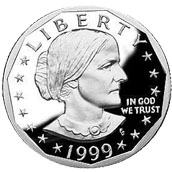
Anthony's birthplace in Adams was purchased in August 2006 by Carol Crossed, founder of the New York chapter of Democrats for Life of America, affiliated with Feminists for Life (FFL).[20] Anthony's childhood home in Battenville, New York, was placed on the New York State Historic Register in 2006, and the National Historic Register in 2007.[21]

The Susan B. Anthony House in Rochester was declared a National Historic Landmark in 1966 and was operated as a museum.[22]
The American composer Virgil Thomson and poet Gertrude Stein wrote an opera, The Mother of Us All, that abstractly explores Anthony's life and mission. Along with Elizabeth Cady Stanton and Lucretia Mott, she is commemorated in The Woman Movement, a sculpture by Adelaide Johnson, unveiled in 1921 at the United States Capitol.
Anthony's position on abortion (or lack thereof) has been the subject of a long-running dispute.
See also
References
- ^ Kennedy, Patricia Scileppi; O'Shields, Gloria Hartmann (1983). We shall be heard: women speakers in America, 1828–present. Kendall/Hunt Pub. Co. p. 78.
In response to a letter received in 1897 inquiring as to the number of lectures and speeches delivered during her life, she explained she probably averaged 75–100 per year.
- ^ http://worldconnect.rootsweb.ancestry.com/cgi-bin/igm.cgi?op=GET&db=glencoe&id=I34357
- ^ Harper, Ida Husted (1899). The Life and Work of Susan B. Anthony: including public addresses, her own letters and many from her contemporaries during fifty years. Vol. Vol. 1. Indianapolis & Kansas City: The Bowen-Merrill Company. pp. 21–22 (n62–63 in electronic page field). Retrieved 22 January 2010.
{{cite book}}:|volume=has extra text (help) Full text at Internet Archive. - ^ Harper (1899) Vol.1, pp.13–14.
- ^ Quoted in The History of Woman Suffrage, vol. 3, ch. 27, by Elizabeth Cady Stanton, Susan B. Anthony, and Matilda Joslyn Gage (1886).
- ^ Miller, 314
- ^ Hays, Elinor Rice. Morning Star: A Biography of Lucy Stone 1818–1893. Harcourt, Brace & World, 1961, p. 88. ISBN 0347937567
- ^ Harper (1899), Vol.1, p.64.
- ^ Blackwell, Alice Stone. Lucy Stone: Pioneer of Woman's Rights. Charlottesville and London: University Press of Virginia, 2001, p. 101. ISBN 0-8139-1990-8
- ^ Stanton, 1997, pp. 26–27.
- ^ Streitmatter, Rodger (2001). Voices of revolution: the dissident press in America. Columbia University Press. p. 51. ISBN 0231122497.
- ^ Streitmatter, 2001, p. 52
- ^ Linder, Douglas: "The Trial of Susan B. Anthony for Illegal Voting," University of Missouri-Kansas City School of Law, at http://jurist.law.pitt.edu/trials14.htm
- ^ Harper, Ida Husted (1898). The Life and Work of Susan B. Anthony. Vol. Vol. 2. Indianapolis: Hollenbeck Press. p. 574 (n91 in electronic field). Retrieved 22 January 2010.
{{cite book}}:|volume=has extra text (help) Full text at Internet Archive. - ^ "Western New York Suffragists - Women Educational and Industrial Union". Rochester Regional Library Council. 2000. Retrieved 2008-07-16.
- ^ Phelps, Elizabeth Stuart, and Carol Farley Kessler (1985) The Story of Avis, p. xv. Rutgers University Press. ISBN 0813510996
- ^ Stanton, Elizabeth Cady, and Susan Brownell Anthony. Edited by Ellen Carol DuBois. The Elizabeth Cady Stanton – Susan B. Anthony reader: correspondence, writings, speeches, pp. 282–283. Northeastern University Press, 1992. ISBN 1555531431
- ^ "Miss Susan B. Anthony Died This Morning". New York Times. March 13, 1906. Retrieved 2009-02-19.
Miss Susan B. Anthony died at 12:40 o'clock this morning. The end came peacefully.
{{cite news}}: Cite has empty unknown parameter:|coauthors=(help) - ^ Harper, Ida Husted (1908). The life and work of Susan B. Anthony. Vol. Vol. 3. Indianapolis: The Hollenbeck Press. p. 1446 (n397 in electronic page field). Retrieved 22 January 2010.
{{cite book}}:|volume=has extra text (help) Full text at Internet Archive. - ^ Schiff, Stacy (2006-10-13). "Desperately Seeking Susan". New York Times. Retrieved July 7, 2010.
That two-story house, a rich but undistinguished piece of real estate perched on a desolate stretch of highway, was sold at auction in August. It belongs now to Carol Crossed, the founder of the New York State chapter of FFL. Crossed made the acquisition on behalf of the national anti-abortion organization, which will manage and care for the house.
- ^ "New women's museum at home of Susan B. Anthony". History News Network. 2007-02-13.
Freddie Mac Bank has donated the childhood home of Susan B. Anthony to New York State Parks Department for $1.
- ^ "Susan B. Anthony House".
1966 - The Susan B. Anthony house is designated a National Historic Landmark
Further reading
- Baker, Jean H. Sisters: The Lives of America's Suffragists. Hill and Wang, New York, 2005. ISBN 0-8090-9528-9.
- Bass, Jack (27 November 2005). Civil Rights: Judges followed Parks' bold lead (op/ed). Atlanta Journal Constitution. Retrieved May 18, 2009.
- Boller, Paul F., Jr. "Presidential Campaigns." Oxford University Press, 1984.
- "From Kansas." Proquest Historical Newspapers Chicago Tribune. 7 September 1876. O1
- Harper, Ida Husted. Life and Work of Susan B. Anthony (3 vols., Indianapolis, 1898–1908)
- Linder, Douglas. Susan B. Anthony: A Biography
- Linder, Douglas. Famous American Trials: The Anthony Trial: An Account Argument for the Defense Concerning Legal Issues in the Case of: United States vs. Susan B. Anthony. 2001. 5 March 2006.
- Linder, Douglas Argument for the Defense Concerning Legal Issues in the Case of United States vs Susan B. Anthony
- McCulloch, John. "The Struggle for Women's Suffrage in Queensland." Hecate: 1874.
- Miller, William Lee (1995). Arguing About Slavery. John Quincy Adams and the Great Battle in the United States Congress. Vintage Books. ISBN 0-3945-6922-9.
{{cite book}}: Unknown parameter|city=ignored (|location=suggested) (help) - Mobley, Kendal. 2005. “Susan B. Anthony and Helen Barrett Montgomery: An Intergenerational Feminist Partnership”. Baptist History & Heritage 40, Summer 80–90
- Patriot Ledger Staff. Role model: Susan B. Anthony to come to life The Patriot Ledger: City Edition. Quincy, MA. 1 March 2006
- Stanton, Elizabeth Cady; edited by Ann D. Gordon; assistant editor Tamara Gaskell Miller. The selected papers of Elizabeth Cady Stanton and Susan B. Anthony, Rutgers, 1997. ISBN 0-8135-2317-6
- Susan B. Anthony (1994). The National Women's History Project. Retrieved 18 March 2006.
- "Susan Brownell Anthony." Women in History. Women in History: Living Vignettes of Women From the Past. 21 March 2006
- "The Women in the Field." Proquest Historical Newspaper Chicago Tribune. 9 July 1868. O3.
- Biography at americola.com
- Western New York Suffragists - Susan Brownell Anthony
External links
- Villard, Fanny Garrison (1920-02-14). "Susan B. Anthony". The Nation. Retrieved 2009-11-21.
{{cite news}}: Cite has empty unknown parameter:|coauthors=(help) [dead link] - The Elizabeth Cady Stanton and Susan B. Anthony Papers Project at Rutgers University
- The Life and Work of Susan B. Anthony (Volume 1 of 2), by Ida Husted Harper at Project Gutenberg
- Susan B. Anthony, by Alma Lutz, 1959, from Project Gutenberg
- Online catalog of Susan B. Anthony's personal library, based on the Susan B. Anthony Collection at the Library of Congress, online at LibraryThing
- Anthony trial
- The Trial of Susan B. Anthony at Project Gutenberg
- U. S. National Archives exhibit of original testimony from the 1872 case
- Photograph portrait from the archives at New York Public Library
- "Miss Susan B. Anthony Died This Morning", New York Times, 13 March 1906
- The Liberator Files, Items concerning Susan B. Anthony from Horace Seldon's collection and summary of research of William Lloyd Garrison's The Liberator original copies at the Boston Public Library, Boston, Massachusetts.
- Susan B. Anthony at Find a Grave
- American skeptics
- American temperance activists
- American suffragists
- American Quakers
- American Unitarians
- People from Rochester, New York
- People from Berkshire County, Massachusetts
- 1820 births
- 1906 deaths
- American abolitionists
- American people of English descent
- Burials at Mount Hope Cemetery, Rochester
- American feminists
